

Bewuste_Overgang 2. What on earth is mindfulness? In the last few years, you might have noticed a new word make its way into the media: “mindfulness”.
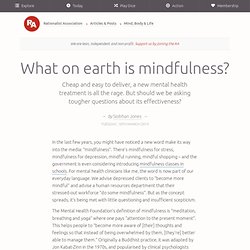
There’s mindfulness for stress, mindfulness for depression, mindful running, mindful shopping – and the government is even considering introducing mindfulness classes in schools. For mental health clinicians like me, the word is now part of our everyday language. We advise depressed clients to “become more mindful” and advise a human resources department that their stressed-out workforce “do some mindfulness”. But as the concept spreads, it’s being met with little questioning and insufficient scepticism. The Mental Health Foundation’s definition of mindfulness is “meditation, breathing and yoga” where one pays “attention to the present moment”. NICE, which makes recommendations based on scientific trials, mainly takes its evidence from randomised controlled trials (RCTs), seen as the gold standard of scientific enquiry.
Mindfulness and Stress Reactions: Getting Off the Elevator of Distress. A good friend of mine describes her depression as an elevator that takes her down to an unfurnished basement with toxic mold, the stench of cat urine and no windows.
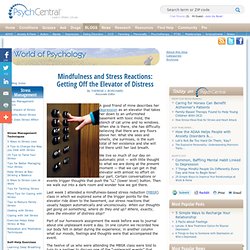
When she is there, she has difficulty believing that there are any floors above her. What she sees and smells, she surmises, is the sum total of her existence and she will rot there until her last breath. Sit. Mindfulness_8wTr_sept-okt_2014_web. Mindfullness. Chakras. Julian Baggini: Is there a real you? Chakras. L'Art-Thérapie, la créativité au secours des émotions. Permettre à chaque individu de comprendre ce qui fait barrage à sa construction ou à la poursuite harmonieuse de sa vie et d’agir en devenant acteur et créateur de son devenir, en ceci réside tout le concept novateur de l’Art-Thérapie.

L’art-thérapie est une technique thérapeutique se basant sur le langage créatif corporel qui peut également être un très bon support de retranscription du langage verbal. En effet, la souffrance qu’elle soit d’ordre physique ou psychique peut se révéler parfois presque paralysante. Il arrive qu’on ne parvienne pas à mettre des mots sur ce qui nous immobilise dans notre douleur ou notre mal être, ou que le travail thérapeutique classique autour de la parole ne soit pas suffisant à faire bouger les choses. C’est ici que l’Art-thérapeute peut intervenir en proposant des ateliers personnalisés en fonction de ce qu’il voit, observe et entend de la souffrance du patient. How To Have An Out Of Body Experience.
Robert Monroe's Method In his book, Journeys Out of the Body, Robert Monroe describes a complicated-sounding technique for inducing OBEs.
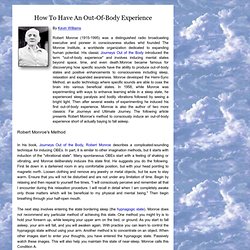
In part, it is similar to other imagination methods, but it starts with induction of the "vibrational state". Many spontaneous OBEs start with a feeling of shaking or vibrating, and Monroe deliberately induces this state first. He suggests you do the following. First lie down in a darkened room in any comfortable position, but with your head pointing to magnetic north. The next step involves entering the state bordering sleep (the hypnagogic state).
After first achieving this state, Monroe recommends to deepen it. Once you have achieved the vibrational state, you have to learn to control it, to smooth out the vibrations by "pulsing" them. To leave the body, Monroe advocates the "lift-out" method. Research Mapping Human Emotions Shows Strong Mind Body Connection. Photo: Bodily topography of basic (Upper) and nonbasic (Lower) emotions associated with words.
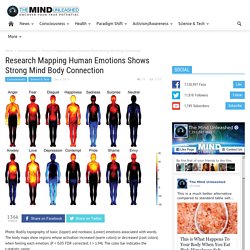
The body maps show regions whose activation increased (warm colors) or decreased (cool colors) when feeling each emotion. (P < 0.05 FDR corrected; t > 1.94). The color bar indicates the t-statistic range. Love makes us warm all over, and now scientists are creating body maps to prove it. A team of scientists in Finland has used a topographical self-reported method to reveal the effects that different emotional states have on bodily sensations. Most basic emotions were associated with sensations of elevated activity in the upper chest area, likely corresponding to changes in breathing and heart rate (1). Research on behavioral and physiological responses to emotions could help in understanding mood disorders such as anxiety and depression. 10 Ways to Shift Your Consciousness. By Paul Lenda Guest Writer for Wake Up World In moments of stress, anxiety and other intense harmful mind states that we experience within our lives, it can be difficult to have our focus on positive personal development.
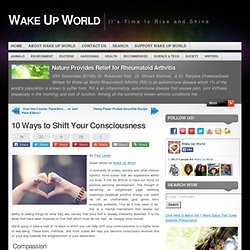
The thought of becoming an enlightened sage radiating seemingly-perpetual positive energy can seem far off…an unattainable goal given life’s everyday problems. True as it may seem to be, this is a mental mechanism that blocks our ability to seeing things for what they are, namely that “your Self is already inherently liberated. It is the ideas that have been imposed on that Self which must be set free”, as Gangaji once mused. We’re going to take a look at 10 ways in which you can help shift your consciousness to a higher level of well-being. Compassion By being compassionate, we embrace the sympathetic consciousness of others’ distress together with a desire to alleviate it.
» 9 Mindfulness Rituals to Make Your Day Better. “Smile, breathe and go slowly.” - Thich Nhat Hanh, Zen Buddhist monk Post written by Leo Babauta.
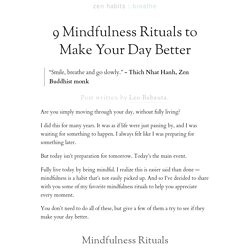
Are you simply moving through your day, without fully living? I did this for many years. It was as if life were just passing by, and I was waiting for something to happen. I always felt like I was preparing for something later. But today isn’t preparation for tomorrow. Fully live today by being mindful. You don’t need to do all of these, but give a few of them a try to see if they make your day better.